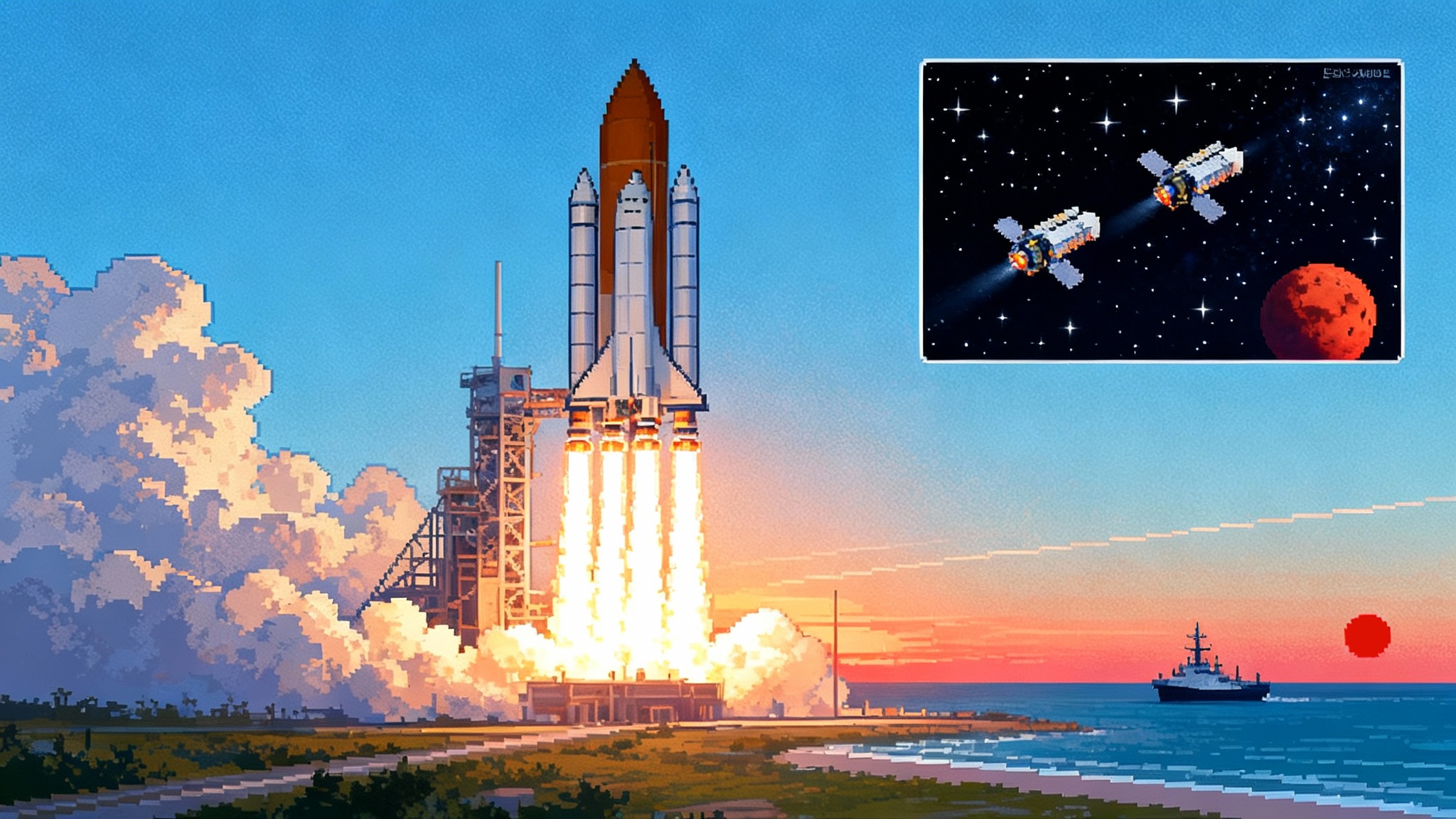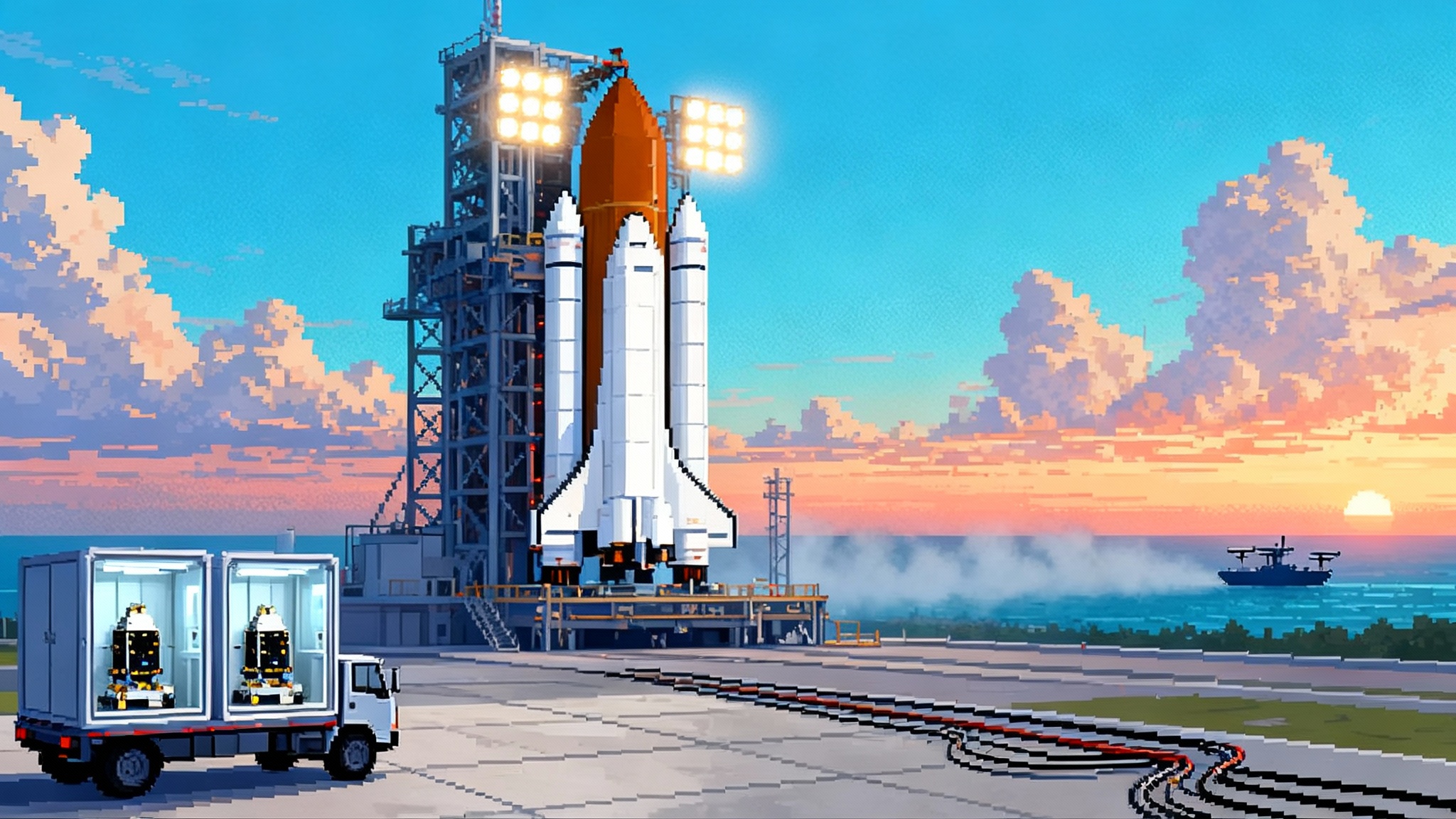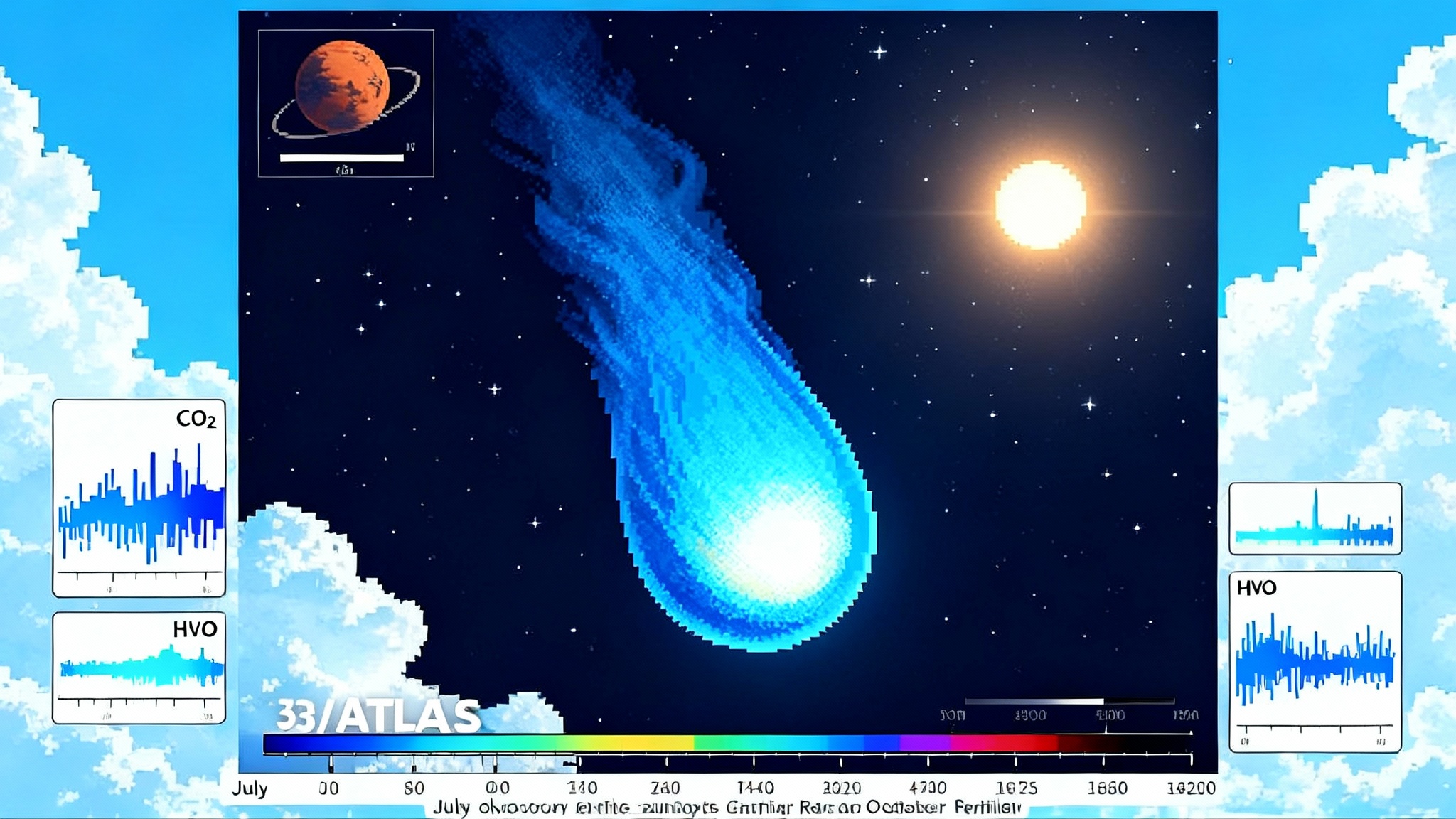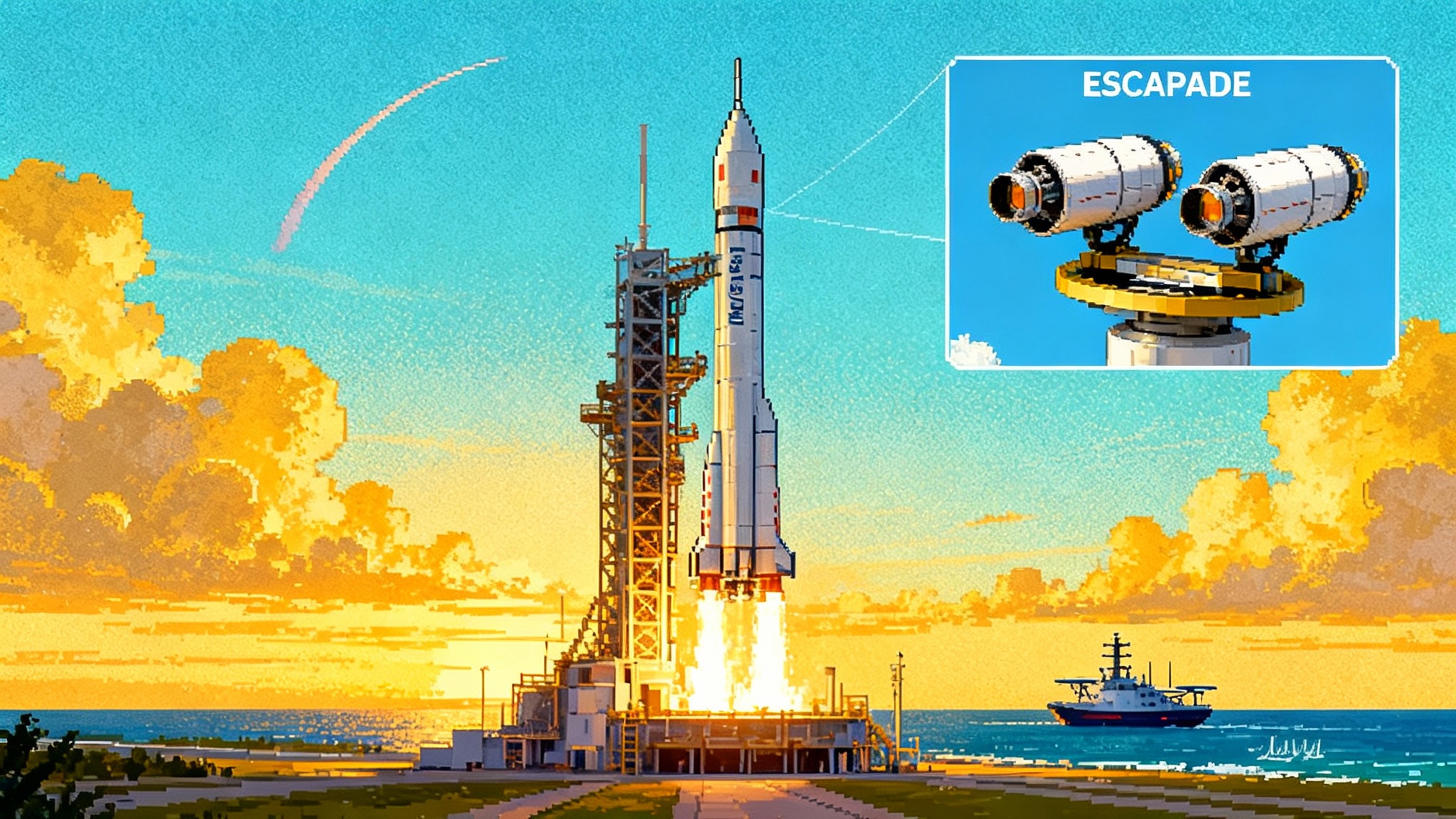New Glenn’s second flight targets Mars with ESCAPADE
Blue Origin plans to send NASA’s twin ESCAPADE probes toward Mars on New Glenn’s second mission as soon as September 29, 2025. Here’s what to watch, why the risks are worth it, and how a small heliophysics mission could reshape deep-space access.

The bold second act
Blue Origin is aiming to send NASA’s twin ESCAPADE spacecraft toward Mars on the second flight of its new heavy lifter, New Glenn, targeting no earlier than September 29, 2025. That jump from debut to interplanetary on flight two is rare and consequential, and it explains why this launch has people across the space community glued to the Cape. Blue Origin’s first New Glenn reached orbit in January, proving the core vehicle, but the booster missed its drone ship landing. Now the company returns with higher stakes, a NASA science payload, and a plan to demonstrate the pieces it still needs to master: reliable engine restarts, booster recovery, and a clean trans-Mars injection. Blue Origin and NASA have publicly pointed to the late September target as the new mark for NG-2 carrying ESCAPADE to the Red Planet, as reflected in a reported late September launch target.
If it flies on time and performs, New Glenn would become only the third active American rocket to send a payload beyond Earth orbit, joining Atlas V and Falcon Heavy. Doing that on flight two could reset expectations for how fast a new launcher can move from a shakedown to real work.
Why this mission matters for interplanetary access
For NASA, getting ESCAPADE to Mars is the immediate goal, but the bigger story is market structure. The agency’s deep-space missions have long depended on a short list of vehicles and schedules. New Glenn adds a fresh heavy platform with a large fairing and an upper stage designed for multiple restarts. If Blue Origin shows it can hit interplanetary performance early, NASA gains schedule options and pricing leverage. That helps everything from modest heliophysics probes to flagship planetary missions. For a deeper strategic read, see why flight two could matter in why flight two could redefine Mars missions.
For the U.S. launch market, NG-2 is a litmus test. It is not enough for New Glenn to reach orbit again. The rocket needs to demonstrate margin, repeatability, and a credible path to reusability. A clean ascent, good stage separation, and a precise upper stage burn sequence would signal that New Glenn can shoulder complex contracts. A successful booster recovery would tighten the economics and shorten refurbishment learning curves. Taken together, those steps would put competitive pressure on incumbents and broaden the bench for deep-space work.
What to watch on launch day
There are three moments that will tell the tale of NG-2.
- Engine restarts and propellant management
- The first stage uses seven methane oxygen BE-4 engines. The landing attempt demands at least one re-ignition. After the first flight’s missed drone ship recovery, Blue Origin has focused on how residual propellant is conditioned and how engine start sequences are managed in the dynamic, low pressure landing environment. Watch for language on the webcast about updated bleed procedures, thermal conditioning, and ignition margins. A clean re-ignition near the landing attempt would be the most visible sign that the company has closed a key loop.
- The second stage flies two hydrogen oxygen BE-3U vacuum engines that are built to restart multiple times. That capability is what lets New Glenn shape orbits, raise perigee, and then perform a trans-Mars injection. Expect at least two upper stage burns: one to reach a stable parking orbit and one for the long injection. A third burn is possible depending on final mass properties and mission design. Smooth, on-time restarts will matter as much as raw thrust.
- The booster recovery attempt
- New Glenn’s first stage is designed for ship landings. On NG-2, the recovery profile will look similar to the debut, with an entry burn to manage heating and a landing burn to touch down on the drone ship. The landing is not required for ESCAPADE to succeed, but it is central to New Glenn’s long term economics. A stable hover-slam and clean touchdown would validate throttle control, guidance, and updated ignition procedures under real loads.
- The trans-Mars injection burn
- This is the mission’s make-or-break moment for ESCAPADE. After coast and reorientation in parking orbit, the BE-3Us must produce a sustained, precisely timed burn that hits a tight corridor of velocity and departure geometry. TMI accuracy directly reduces the amount of course correction fuel ESCAPADE must spend during cruise, which buys margin for Mars orbit insertion and formation operations.
How the flight profile sets up Mars
- Liftoff and ascent: Seven BE-4s push the 98 meter tall stack off Cape Canaveral’s LC-36. Max-Q comes roughly a minute into flight. Stage separation follows at several kilometers per second.
- Upper stage parking burn: The twin BE-3Us light to place the stack in a temporary Earth orbit. This allows time for systems checks and for the stage to coast to the proper injection point.
- Trans-Mars injection: The upper stage restarts and pushes the ESCAPADE stack onto an escape trajectory. If New Glenn is tasked to deliver a direct C3 energy, the burn duration and timing are tuned to minimize ESCAPADE’s own propulsive work later. If the team opts for a hybrid profile, the stage may drop off the pair on a slightly different energy and geometry that ESCAPADE refines with its own propulsion.
- Separation and cruise: ESCAPADE’s twin spacecraft separate and begin cruise operations, performing trajectory correction maneuvers and health checks en route to Mars.
For a program-level preview of why NASA accepted this risk profile, see our Mars bet overview in our Mars debut explainer.
ESCAPADE in plain English
ESCAPADE stands for Escape and Plasma Acceleration and Dynamics Explorers. It is a pair of small orbiters that will fly in formation at Mars to study the planet’s magnetic environment and how the solar wind strips away the upper atmosphere. Think of it as a stereo microphone for space weather around Mars. One spacecraft samples conditions nearer to the planet while the other looks farther out, then they swap. That dual perspective is the core innovation.
Each probe carries a compact but targeted instrument suite. A magnetometer sits on a boom to measure small changes in the magnetic field. An electrostatic analyzer counts and sorts energetic ions and electrons. A plasma probe watches the density and temperature of the charged gas. With those three data streams synchronized across two vantage points, the team can watch energy from the Sun move through Mars’ patchy magnetosphere, into the ionosphere, and out into space. For official background and goals, start with NASA’s ESCAPADE mission overview.
The payoff is practical. Mars has only remnant crustal magnetism in places, not a strong global field like Earth. The solar wind can therefore buffet the atmosphere directly. Understanding where and when that erosion accelerates is essential for predicting atmospheric loss and radiation exposure. The answers feed planning for aerocapture, communications, and radiation shielding on future missions. ESCAPADE’s approach complements the deep, single point measurements from NASA’s MAVEN by adding simultaneous measurements at two locations. The science also connects to what Perseverance is finding in Jezero, including Perseverance’s Sapphire Canyon biosignature work.
Why flying a Mars probe on flight two is not reckless
There is a reason NASA put ESCAPADE on New Glenn under its Venture-class Acquisition of Dedicated and Rideshare services. VADR is designed for lower cost, more risk tolerant science missions that can accept the learning curve of newer rockets. ESCAPADE is not a flagship, but it answers high value questions. It is exactly the kind of mission you pick to expand launch options.
On the vehicle side, New Glenn’s second stage is hydrogen fueled and restartable, which is the architecture you want for high energy departures. The system has gone through hot fire tests as an integrated stage, and the debut flight exercised much of the avionics, guidance, and thermal sequencing in flight. What remains to prove is repetition and the last mile details: ignition conditioning, fluid behavior at low acceleration, and descent control on the booster. These are fixable engineering problems, not fundamental architecture issues.
The stakes for NASA
- Schedule resilience: A new heavy launcher that can do interplanetary work reduces single point dependence and lets NASA mix and match missions to the right ride.
- Cost shaping: Even if price parity does not arrive quickly, credible competition disciplines prices. That matters for everything in the pipeline, including weather satellites, lunar logistics, and the next round of planetary probes.
- Mars prep: ESCAPADE’s data will inform aerothermal models, comms blackout predictions, and radiation estimates that feed both robotic and future human mission designs.
- Cultural signal: Backing a second flight for a Mars injection says the agency is serious about using commercial capability as it matures, not just when it is perfect.
The stakes for Blue Origin and the market
- Credibility sprint: Reaching orbit once is a milestone. Reaching orbit twice, hitting a precise departure, and recovering the booster would mark the transition from promise to product.
- Reusability economics: A booster landing is not required for this mission, but it is essential for the long term business case. Successful recovery cuts per-flight hardware cost and opens the door to higher cadence.
- Interplanetary credentials: Delivering a NASA payload onto a Mars trajectory on flight two would instantly add a new category to New Glenn’s sales brochure.
- Competitive balance: A strong NG-2 would force rivals to keep sharpening their pricing and cadence. Customers benefit when there are multiple reliable rides to every orbit and beyond.
How a small mission can swing big
ESCAPADE shows how two ideas compound. First, dual spacecraft provide context and causality in a way single probes cannot. Second, pairing a small mission with a heavy launcher can accelerate deep-space access if the rocket is available and the mass margins are generous. The risk is schedule exposure if the new rocket slips. NASA mitigated that risk by pulling ESCAPADE off New Glenn’s debut when the 2024 window narrowed, then returning once the first flight was in the books. That was a pragmatic call that preserved the spacecraft and budget while keeping the door open to fly early in the next window.
If ESCAPADE arrives on schedule and produces months of clean dual-point data, the mission will give engineers and scientists what they need to cut uncertainty in models that touch nearly every Mars planning conversation. That is a lot of leverage for a compact probe pair.
What could go wrong, and how to think about it
- Weather or range: The Cape can be fickle. Scrubs are common. Expect some schedule churn around the target date.
- Booster landing: Even with fixes, landing a tall, wide-core booster at sea is hard. Missing the ship again would be disappointing but not fatal to the mission. The key is learning and trend lines.
- Upper stage restart: A failed restart would end the Mars attempt. This is the riskiest remaining technical step for the vehicle.
- TMI accuracy: Hitting the departure box with less dispersion reduces ESCAPADE’s cruise fuel burn. If dispersion is larger than planned, the spacecraft can compensate, but that eats margin at Mars.
- Late-stage integration issues: Payload adapters, separation hardware, and upper stage environments are always places to watch closely on newer rockets.
The telltales in the telemetry
If you are watching the broadcast and want to gauge how things are going, listen for these cues.
- “Nominal engine chill, nominal bleed” on the first stage near landing burn. That hints the ignition environment is where the team wants it.
- “Upper stage chamber pressure steady” on restart. That is the confirmation the BE-3U ignition sequence behaved and the burn is on spec.
- “Guidance converged” near the end of TMI. That phrase means the target parameters for ESCAPADE’s separation are within the box.
- “Vehicle safed, recovery underway” from the drone ship team. That is your sign the booster is upright and stable.
Bottom line
New Glenn’s second flight is not just another launch. It is a referendum on whether a new heavy launcher can accelerate from first orbit to first interplanetary in a year, while closing the loop on reusability. For NASA, ESCAPADE offers high signal science about Mars space weather on a modest budget. For the U.S. launch market, success would add a second reusable heavy platform with interplanetary reach, which reshapes planning across science and commerce. Watch the restarts. Watch the landing. Watch the injection. If all three go right, interplanetary access gets a little cheaper, a little faster, and a lot more competitive.
For official mission details, see NASA’s ESCAPADE mission overview.








